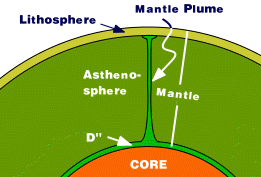|
The Galapagos Mantle Plume
 | | Cross-sectional view of a mantle plume. Figure source: http://www.geo.cornell.edu/geology/GalapagosWWW/GalapagosGeology.html |
Like many oceanic islands, such as Hawaii, the Azores, and Reunion, the Galapagos are thought to be the product of a mantle plume. Mantle plumes are columns of hot rock, roughly 100 km in diameter, that rise from deep within the Earth. These plumes rise because they are hotter (by perhaps as much as 200 degrees centigrade) and therefore less dense, than the surrounding rock. The rate of ascent is about 10 cm/year. The depth from which mantle plumes rise is, however, still a matter of scientific debate; some believe that plumes originate at a shallower depth, such as the boundary between the upper and lower mantle at 670 km, others believe they come from greater depth. One idea is that mantle plumes form at the base of the Earth's mantle, at a depth of 2,900 km, where a layer of rock called D'' (D-double prime) is heated by the Earth's liquid iron core beneath it. One reason scientists believe that mantle plumes come from great depth is that they remain fixed relative to one and other over many tens of millions of years, even though the lithospheric plates above them move thousands of kilometers in this time. Thus the distance between the active Galapagos and Hawaiian volcanoes has remained fixed, even though the volcanos are carried off in opposite directions by lithospheric motion.
|







